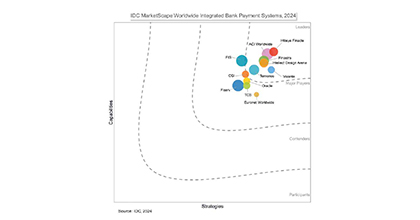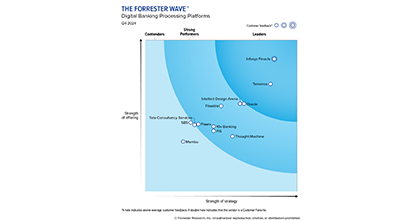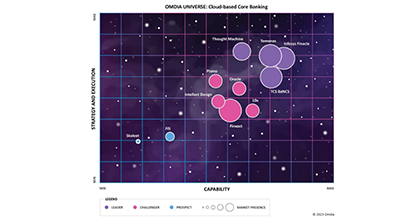-
![]() Quantum Computing: As the Future Awaits, The Strides Are DefinitiveQuantum computing is no longer confined to theory or the edges of experimental science - it is rapidly advancing toward practical impact.Read More
Quantum Computing: As the Future Awaits, The Strides Are DefinitiveQuantum computing is no longer confined to theory or the edges of experimental science - it is rapidly advancing toward practical impact.Read More -
![IDC IDC]() IDC MarketScape: Worldwide Integrated Bank PaymentFinacle Payments is an enterprise payments services system that manages end-to-end payments across instrument types, payment schemes, transaction types, customeRead More
IDC MarketScape: Worldwide Integrated Bank PaymentFinacle Payments is an enterprise payments services system that manages end-to-end payments across instrument types, payment schemes, transaction types, customeRead More -
![]() Supply Chain FinanceToday, as businesses seek to make their ecosystems more resilient, Supply Chain Finance (SCF) has emerged as a powerful lever for banks and financial institutions to support clients, while unlocking new revenue streams.Read More
Supply Chain FinanceToday, as businesses seek to make their ecosystems more resilient, Supply Chain Finance (SCF) has emerged as a powerful lever for banks and financial institutions to support clients, while unlocking new revenue streams.Read More
-
![]() The Future of Core Banking: Business and Technology EvolutionOur point of view paper, “The Future of Core Banking: Business and Technology Evolution”, serves as a candid and forward-looking benchmark of your institution’s readiness—and a strategic playbook for core modernization.Read More
The Future of Core Banking: Business and Technology EvolutionOur point of view paper, “The Future of Core Banking: Business and Technology Evolution”, serves as a candid and forward-looking benchmark of your institution’s readiness—and a strategic playbook for core modernization.Read More -
![The Forrester Wave The Forrester Wave]() Forrester Wave Digital Banking, Q4 2024Finacle is best suited for large retail, SMB, and corporate banks who seek a modern, comprehensive, innovative platform with superior support.Read More
Forrester Wave Digital Banking, Q4 2024Finacle is best suited for large retail, SMB, and corporate banks who seek a modern, comprehensive, innovative platform with superior support.Read More -
![]() Driving Comprehensive Revenue ManagementDiscover why revenue management must evolve into a comprehensive, strategic capability. Decode a blueprint to overcome challenges and unlock sustainable monetization.Read More
Driving Comprehensive Revenue ManagementDiscover why revenue management must evolve into a comprehensive, strategic capability. Decode a blueprint to overcome challenges and unlock sustainable monetization.Read More
-
![]() Shaping Banking’s Next: Banking Technology Trends for 2025 and BeyondThe banking industry has been balancing disruption and opportunity for several years now, and the pace of change shows no signs of slowing as we move into 2025 and beyond.Read More
Shaping Banking’s Next: Banking Technology Trends for 2025 and BeyondThe banking industry has been balancing disruption and opportunity for several years now, and the pace of change shows no signs of slowing as we move into 2025 and beyond.Read More -
![]() Virtual Accounts 2.0: Surpass Conventional Cash Management and Unlock Next-Gen PossibilitiesVirtual Account Management was a groundbreaking shift in the banking landscape, revolutionising use cases like cash concentration, pooling, centralised treasury management, and in-house banking (POBO, ROBO, COBO)Read More
Virtual Accounts 2.0: Surpass Conventional Cash Management and Unlock Next-Gen PossibilitiesVirtual Account Management was a groundbreaking shift in the banking landscape, revolutionising use cases like cash concentration, pooling, centralised treasury management, and in-house banking (POBO, ROBO, COBO)Read More -
![]() Unlocking Hybrid CloudAs banks push forward with their digital transformation agenda, cloud serves as a pivotal enabler. Each bank, at varying stages of adoption, crafts its unique path, dictated by context, regulations, and risk appetite.Read More
Unlocking Hybrid CloudAs banks push forward with their digital transformation agenda, cloud serves as a pivotal enabler. Each bank, at varying stages of adoption, crafts its unique path, dictated by context, regulations, and risk appetite.Read More
-
![]() Banking on CloudThis report from Infosys Finacle delves into the need for accelerating cloud adoption, highlights the current state of the industry, and puts forth key recommenRead More
Banking on CloudThis report from Infosys Finacle delves into the need for accelerating cloud adoption, highlights the current state of the industry, and puts forth key recommenRead More -
![]() Omdia Universe | Cloud-based Core BankingIn the report, Omdia highlights the following key capabilities of leading cloud-based core banking providers:Read more
Omdia Universe | Cloud-based Core BankingIn the report, Omdia highlights the following key capabilities of leading cloud-based core banking providers:Read more
-
![]() Emirates NBDEmirates NBD consolidates its operations on a single version for scalability, agility, and standardization.Read More
Emirates NBDEmirates NBD consolidates its operations on a single version for scalability, agility, and standardization.Read More -
![]() A Global Top 5 BankDiscover how a global top 5 bank headquartered in the US accelerated payments transformation.Read More
A Global Top 5 BankDiscover how a global top 5 bank headquartered in the US accelerated payments transformation.Read More -
![]() Union Bank of IndiaUnion Bank of India launches Union Virtual Connect (UVConn) by leveraging WhatsApp to provide customers personalized banking services.Read More
Union Bank of IndiaUnion Bank of India launches Union Virtual Connect (UVConn) by leveraging WhatsApp to provide customers personalized banking services.Read More

Customer 360: Shaping the Future of Customer Relationships in Banking
Blogs
What is Customer 360?
A consistent question in digital banking transformations: “How does a retail banking team actually get the whole picture of a customer instantly and accurately?” That’s the challenge Customer 360 addresses. Not every institution has solved it, and some still wrestle with data fragmentation and inconsistencies. Yet the expectation is clear: from a mid-year portfolio review in Mumbai to a cross-border payment in Singapore, staff need relevant, real-time intelligence on any customer’s relationship, including transaction history, support cases, campaign responses, loan lifecycle, even channel preferences.
For years, banks stitched together partial profiles from siloed systems. Legacy platforms, often over a decade old, leave gaps like the classic “one customer, several records” problem. Customer 360 seeks to change that dynamic by aligning core, digital, and engagement layers. The goal isn’t simply aggregation but getting operational clarity. This clarity helps enable the same data to fuel both compliance checks and next-best-offer recommendations.
Why do banks need Customer 360?
It’s no longer enough for banks to know the basics about their customers, not when fintech firms and neobanks are defining benchmarks for personalization and speed. Consider just a few realities: onboarding timelines are tight, and some institutions now commit to 48-hour digital account setup. Regulators are mandating dynamic AML/KYC checks on every transaction, not just at onboarding. Portfolio managers expect alerts when a high-value SME approaches a credit utilization threshold, in real time.
Without a true Customer 360, inconsistencies are inevitable: relationship managers chasing missing paperwork; compliance staff repeating ID checks; customers repeating grievances through multiple channels, leading to attrition in high-value segments. Unifying data closes these gaps, but it also unlocks proactive service. For instance: a bank running Basel III risk analytics can correlate customer-level exposures for precise capital allocation or surface an early-warning alert if a client’s transfer behavior deviates outside their established pattern. These are not theoretical use cases, they inform daily operational decisions.
Finacle Customer Data Hub: Customer 360 but better
Delivering on the Customer 360 vision is rarely plug-and-play. The data hub must reconcile disparate core, digital, and partner systems, often with overlap, occasionally with contradictions in customer identifiers. Here is where Finacle Customer Data Hub changes the equation. Through open APIs, historical data from a 15-year-old loan origination tool can connect with new digital onboarding modules. Record linkage resolves common mismatches (e.g., spelling variations, legacy account mergers), and the data governance layer audits every update which is critical, because cross-border data sharing today requires audit trails as granular as “record updated, field value changed, source system ID.”
A static 360-degree view is already outdated by the time it’s compiled. Finacle enables continuous updates, so patterns emerge quickly: say a retail customer shifts payment behavior right after an interest rate update, or a corporate client’s monthly transaction volume jumps after a merger announcement. This allows for actions that are specific and timely like automated product suggestions or a manual compliance review when required. In practice, it might mean reducing loan approval cycles from 48 hours to just 6, all while keeping internal controls intact.
Infosys Finacle’s architecture demonstrates what a practical solution looks like. Unlike simple dashboards, Finacle weaves compliance (e.g., immediate KYC refreshes when regulations tighten) and analytics (anomalous transaction flagging within seconds) into banking workflows. The modular approach enables product enhancements without stepping outside regulatory guardrails, important in regions where frameworks routinely shift every 12–18 months. The value isn’t just speed, it’s resilience making banks less vulnerable to operational blind spots that can lead to regulatory censure or lost revenue.

Download the Latest Report
The Future of Core Banking: Business and Technology Evolution


©2025 -Edgeverve Systems Limited | All rights reserved















